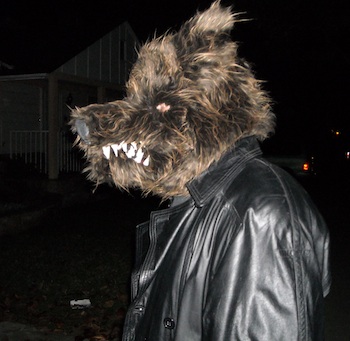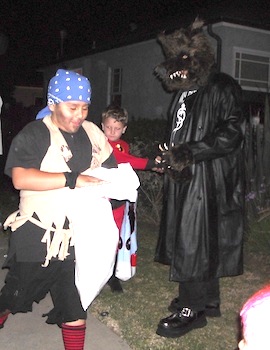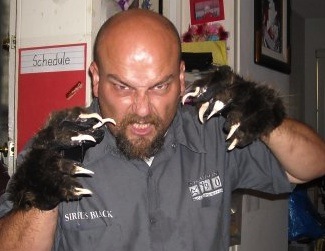Why aren’t werewolves as popular as vampires?
When I was a junior in high school, I read Interview with the Vampire and, soon after, The Vampire Lestat, and I really wanted to be a vampire (though Anne Rice’s other novels all fell flat for me). Tortured souls, doomed for all eternity…well, I felt like a tortured mortal already. Vampires were always sexy and fast and melodramatic, and I only ever managed one of the three.
As everyone in the universe knows, vampires are popular. Lots of people fantasize about being a vampire. I think True Blood has it right: if vampires were real, they’d have groupies, in abundance.
Also perennially popular are zombies, but no one I know of wants to be one. And then there are werewolves. Far from obscure. Everyone knows what a werewolf is. There’s no denying, though, that werewolves simply don’t get the love the upper-fang set gets.
I’ve always liked them, the way the howl and get all toothy and tear shit up and whatnot. But I had never daydreamed about being a werewolf until two Halloweens ago when I decided to make a werewolf costume (pictured throughout the post because I’m a show-off). Since then, they have totally replaced their pale cousins, in my heart.
Werewolves—I’m talking about werewolves specifically and not more broadly about shapeshifters of other sorts—have been part of myth and folklore for a very long time. Ovid wrote of them in Metamorphosis, telling the story of Lycaon, a crazy-ass king who served Zeus a chunk of human for dinner. Zeus frowned on this sort of shenanigans—perhaps more upset that Lycaon tried to fool him than that he ate some man-beef—and turned Lycaon into a wolf and sent out lightning to kablooey Lycaon’s palace.
 In modern stories, werewolves and vampires are often enemies, but modern vampires and werewolves come from the same Slavic folkloric source. The vampire wasn’t a completely separate creature from the werewolf until fairly recently. Words like upir, strigoi and vukodlak all refer not specifically to the modern concept of vampire or werewolf but to an evil, magical undead creature who might turn into a beast, might drink your blood, might molest the miller’s wife…whatever’s clever. For a working description of these wizard-vampire-werewolves, we need look no further than the Prince of Darkness himself, Ozzy. The subject of “Bark at the Moon” isn’t just a werewolf. He’s a malevolent spirit, cursed and buried who emerges to take vengeance. He’s your old world Balkan-style bad dude, essentially.
In modern stories, werewolves and vampires are often enemies, but modern vampires and werewolves come from the same Slavic folkloric source. The vampire wasn’t a completely separate creature from the werewolf until fairly recently. Words like upir, strigoi and vukodlak all refer not specifically to the modern concept of vampire or werewolf but to an evil, magical undead creature who might turn into a beast, might drink your blood, might molest the miller’s wife…whatever’s clever. For a working description of these wizard-vampire-werewolves, we need look no further than the Prince of Darkness himself, Ozzy. The subject of “Bark at the Moon” isn’t just a werewolf. He’s a malevolent spirit, cursed and buried who emerges to take vengeance. He’s your old world Balkan-style bad dude, essentially.
But lets get back to modern werewolves. The silver bullet, uncontrollable, wake-up-naked-covered-in-blood kind of werewolf. Back to my original question. Why are they second rate, compared to vampires?
Ever since the Halloween I mentioned earlier, I have thought about this over and over. I have a few ideas and I would love it if you’d add your thoughts as well.
- The Lord Byron Factor: John William Polidori, author of the first vampire story in English, was Byron’s personal physician for a while. Lord Ruthven, his vampire, is clearly based on Byron. The globe-trotting, sexy, wealthy vampire of noble blood has been with us ever since. Werewolves? They’re usually broke, poorly-groomed nobodies.
- Name recognition. Dracula, Lestat, Carmilla, Angel, Spike, and so on (by “and so on” I mainly mean Edward). Just about everyone can rattle off a list of well-known vampires. But werewolves? None that I can think of are anywhere near as famous as Dracula or even Angel. Professor Lupin from Harry Potter, Oz from Buffy, and George from Being Human. Alcid from True Blood. I find him dreadfully boring, but I understand he’s a stronger character in the books. Oh, and what’s his face with the abs. You know, Sharkboy.
- Control. Bloodlust for many vampires is like being a horny junkie. But even a horny junkie can hold off for a while. Werewolves do not have that sort of option. They change when the full moon is up, period. Readers are more likely to identify with a character that forces down a destructive urge than one who has no hope of holding it back.
- The rest of the month: A vampire is a vampire all month long. A werewolf is usually just a regular Joe or Jane when the moon isn’t full. (Some werewolf characters are more broadly cyclical, changing subtly throughout the month, and I think that’s cool. But it isn’t the majority).
- Creepysex: Back to the horny junkie concept. Vampire feeding is often tied to sexual dominance, submission and possession (and you could write many books analyzing that). Though pent-up frustrations and the need to let loose can and should play a part in werewolf stories, the beast itself is not, for most of us anyhow, a sexual force. (Unless you’re some teenager with amazing abs, I guess.)
 Since most of us are more likely to fantasize about being sexy and rich and irresistible, vampires win the popularity contest. And because of that, I think, a lot of writers don’t investigate the possibilities of lycanthropy with as much vigor as they do vampirism. There are exceptions, I’m glad to say. Jim Butcher did a good job thinking it through in Fool Moon. Toby Whithouse works to keep George interesting on Being Human. Another Toby (Barlow) did well with his poem-novel Sharp Teeth.
Since most of us are more likely to fantasize about being sexy and rich and irresistible, vampires win the popularity contest. And because of that, I think, a lot of writers don’t investigate the possibilities of lycanthropy with as much vigor as they do vampirism. There are exceptions, I’m glad to say. Jim Butcher did a good job thinking it through in Fool Moon. Toby Whithouse works to keep George interesting on Being Human. Another Toby (Barlow) did well with his poem-novel Sharp Teeth.
In short, lycanthropy needs its Lestat, or better still, its Agyar. Nobody I have read has attempted that kind of personal, detailed, close-up revision of the werewolf myth (if you know of such a book, by all means tell me about it). I think werewolves have every right to be as huge as vampires. Their mythology is as long and as rich. In the hands of the right author or screenwriter, all the deficits I mentioned above could be made into strengths.
Jason Henninger lives in Los Angeles, which would be a pretty lousy place to be a werewolf. No Little Red Riding Hood trick-or-treaters.










